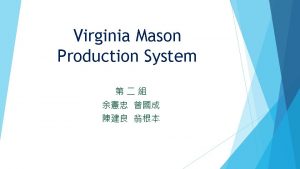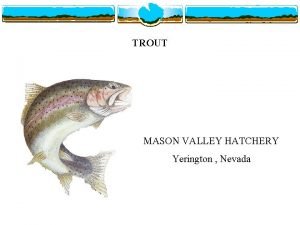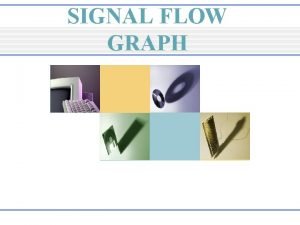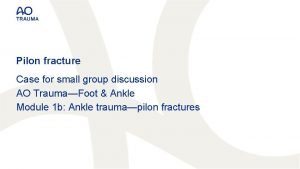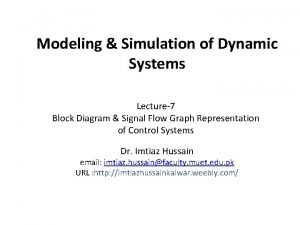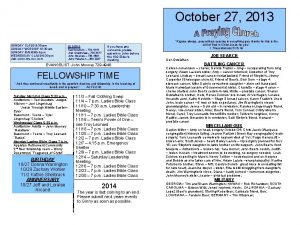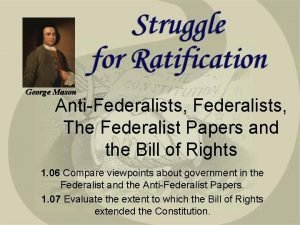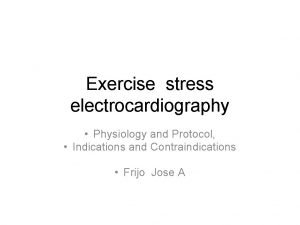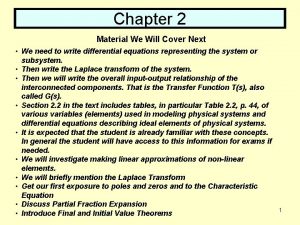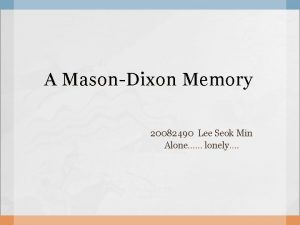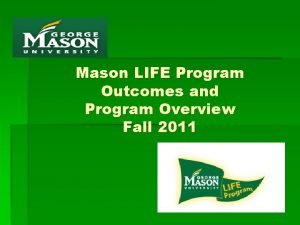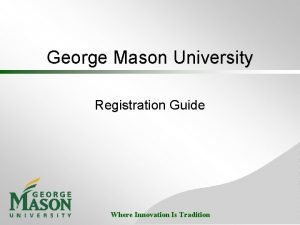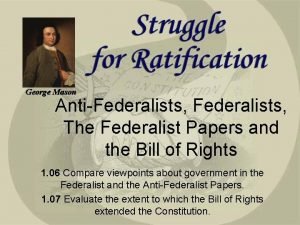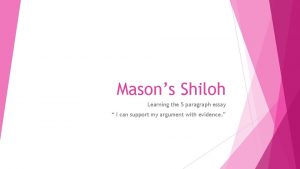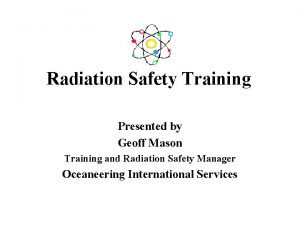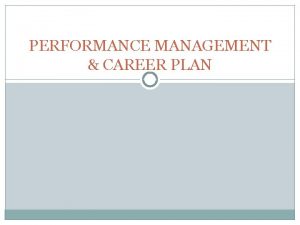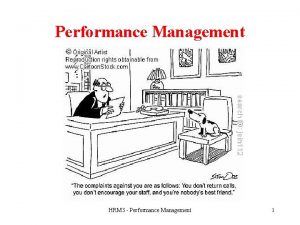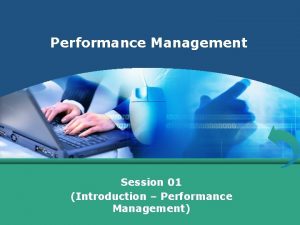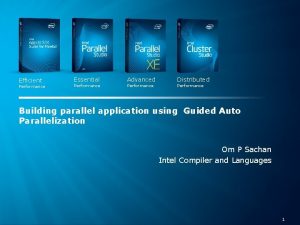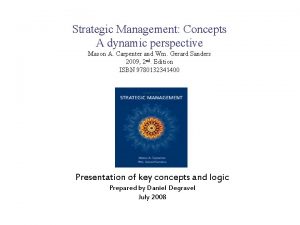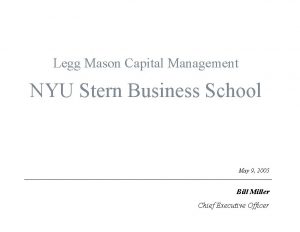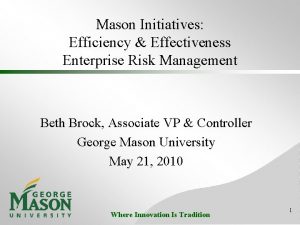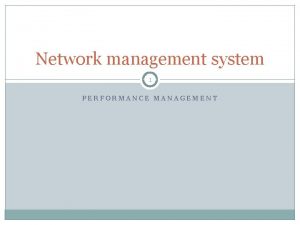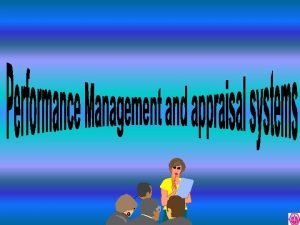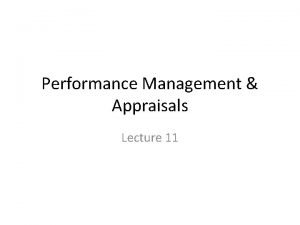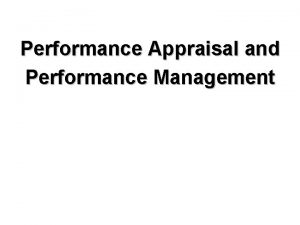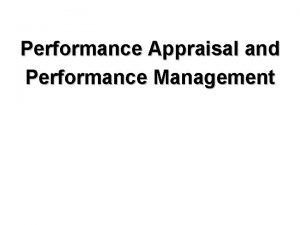Performance Management at Mason Performance Management Performance management















































- Slides: 47

Performance Management at Mason

Performance Management Performance management is the process of: • Defining expectations • Maintaining open communication between supervisor and employee during the year • Linking individual performance to organizational needs • And evaluating performance This is a year-round process

Why should we do it? Performance management techniques help: • high achievers to develop new skills • solid performers to become great • underachievers to improve • create a productive work environment for all

Best practices in performance MGMT When giving feedback, remember to be: • Timely: Don’t wait. Give feedback as soon after the performance takes place (positive and constructive). • Specific: Say exactly what they did that was good or needs improvement. • Sincere: Be honest and open. Tell the person the impact of their performance. • Personal: Adjust the style and method of your feedback to the receiver. • Proportional: Match the intensity of your feedback to the intensity of the behavior.

Importance of Documentation • Counseling memo or Follow-up Email • • • Summarize performance issues (as discussed in meeting, if applicable) List specific examples, instances and any attempts to train/correct Consequences of performance issues on department Desire for performance to change and consequences if doesn’t Next steps • Supervisor Documentation • Supervisor paper file • Online file (excel spreadsheet) • Self email

Performance Appraisal Cycle Classified Staff: Annual cycle from October 25 th through October 24 th Administrative/Professional Faculty: Annual cycle from July 1 st through June 30 th Wage Employees: N/A*

Performance Evaluation Due Dates Evaluation Due Date Where to Send…. Instructional/ Research Faculty 10/24/2019 Dean's Office Administrative/ Professional Faculty 10/24/2019 Supervisor then Human Resources and Payroll Classified 10/24/2019 Human Resources and Payroll Wage (Non-student and Student) No eval required N/A Type of Employee

What is the goal of a performance appraisal? Performance appraisal is a formal discussion between a direct report and a supervisor, for the purpose of discovering how and why the direct report is presently performing on the job, and how the direct report can perform more effectively in the future, so that the direct report, the supervisor, and the university all benefit.

The supervisor is responsible for: • Developing the work tasks, duties and performance expectations (the work profile or position description) • Providing feedback regarding performance • Offering opportunities for development • Conducting the performance appraisal

Faculty and Staff members should: • Seek assistance with/and clarify responsibilities as needed • Do a self-evaluation • Actively participate in the appraisal discussion • Identify ideas for developmental goals

Due Dates The evaluation form must be completed, signed and dated by the employee, supervisor, and reviewer, and submitted to Human Resources by October 24 th Individual Departments may have unique deadlines earlier than October 24 th. Check with your HR Liaison for more information

Where to find the performance evaluation forms: Go to: hr. gmu. edu • Select the Classification and Compensation tab • Select the Performance tab * For the EWP and Position Description forms, select the Position Creation and Maintenance tab

Classified Evaluation Forms Let’s look at the forms… • AP Faculty Position Description • AP Faculty Performance Evaluation – Includes Self-Evaluation • Employee Work Profile (EWP) – Classified: Supervisory and Non-Supervisory • Classified Self-Evaluation • Classified Performance Evaluation – Supervisory and Non-Supervisory • Performance Ratings for Classified Employees • Acknowledgement of Extraordinary Contribution • Probationary Progress Review • Notice of Substandard Performance • Core Competencies

Classified Staff Self-Assessment • Not required. • A good way to gather input; increase involvement and commitment. • Give to your supervisor before your annual evaluation meeting. • Meet with your supervisor to discuss your annual evaluation and the selfassessment.

Classified Appraisal Areas • Evaluation of Work Tasks and Duties (EWP) • Core Competencies • Non-supervisors have seven • Supervisors have nine – Addition of Leadership and Mentoring & Coaching • Overall Performance Rating

Core Competencies • Accountability • Mentoring & Coaching* • Collaboration & Civility • Strategic & Constituent Focus • Communication • Stewardship • Diversity & Inclusion • Self-Development • Leadership* *AP Faculty and Supervisory Classified only

Classified Performance Ratings E H A F U GMU Ratings State Equivalent Ratings Exceptional High Performing Proficient Developing/Fair Unsatisfactory E C C C B Extraordinary Contributor Below Contributor

Exceptional Performance Rating In order to be eligible to earn an overall “Exceptional” rating on the annual evaluation, an employee must have received at least one “Performance Management Acknowledgement of Extraordinary Contribution” form during the performance cycle.

Exceptional Performance Rating • Pay special attention to goal setting—time to raise the bar? • Consider special recognition

Unsatisfactory In order to be rated “Unsatisfactory”, a classified employee must be issued: • a “Notice of Improvement Needed/ Substandard Performance” form OR • a formal Written Notice (Group I, II, or III) during the performance cycle The supervisor MUST consult with HR before issuing an “Unsatisfactory” rating on an evaluation.

Unsatisfactory Employees that receive an Unsatisfactory rating must be issued a performance improvement plan and be re-evaluated at the end of three (3) months If performance does not improve: Demotion or re-assignment Reduced Duties Termination

Admin/Professional Faculty Forms The forms for Administrative and Professional Faculty are different from Classified employees …

AP Faculty Self-Evaluation & Performance Evaluation The AP Faculty Performance Evaluation is combined with the Self-Evaluation on one form.

AP Faculty Self-Evaluation & Performance Evaluation • Goals (Completed by Supervisor and Employee) • Achievement of agreed-upon performance goal(s) • New initiatives, opportunities, or projects not part of the agreed-upon performance goal(s) • Performance, professional development, and/or community service goals for next year • Core Competencies (Completed by Supervisor and Employee) • Includes Supervisory - Leadership and Mentoring & Coaching • Overall Performance Level • Completed by Supervisor only

AP Faculty Overall Performance Levels __Exceptional – Performance is generally superior and frequently exceeds expectations, making positive contributions to the unit/University. __ High Performing – Performance is consistently high and makes positive contributions to the unit/University. __ Proficient – Performance fully meets standards and makes positive contributions to the unit/University. __ Developing/Fair – Performance falls short of meeting expectations resulting in decreased effectiveness to the unit/University. __ Unsatisfactory – Performance consistently fails to meet expectations, not effectively contributing to the goals of the unit/University.

Unsatisfactory Performance If an Admin/Professional Faculty member receives a performance rating of “Unsatisfactory”, it can be grounds for termination of appointment. The supervisor must consult with HR prior to issuing an unsatisfactory rating on an evaluation.

Pitfalls Halo Effect Horns Effect Personal Bias Santa Claus Effect

Pitfalls Halo Effect The halo effect is a type of cognitive bias in which our overall impression of a person influences how we feel and think about his or her character. Essentially, your overall impression of a person ("He or she is nice!") impacts your evaluations of that person's specific traits ("He or she is also smart!").

Pitfalls Horn Effect The horn effect, closely related to the halo effect, is a form of cognitive bias that causes one's perception of another to be unduly influenced by a single negative trait.

Pitfalls Personal Bias is finding common ground with an employee like you. For example, you may have gone to same college, you may live in the same neighborhood and like the same sports teams.

Pitfalls Santa Claus Effect The Santa Claus Effect is being lenient because the person may have brought you gift; as result, that becomes your focus versus their actual performance.

Mitigating Circumstances Were there circumstances beyond the employee’s control that made it impossible to achieve their goals? – Internal Factors? – External Factors?

Remember: A performance appraisal is a formal discussion between a direct report and a supervisor, for the purpose of discovering how and why the direct report is presently performing on the job, and how the direct report can perform more effectively in the future, so that the direct report, the supervisor, and the university all benefit.

Before the Meeting • Review performance evaluation policy • Review employee’s self-assessment • Prepare the evaluation • Get approval from Reviewer • Choose suitable location for meeting • Prepare both positive and constructive feedback • Provide evaluation to the employee for review

The Performance Appraisal Meeting The evaluation meeting is essential for good two-way communication between manager and employee. The form is a starting point for discussion and feedback.

During the Meeting • Be specific • Discuss regular, expected performance • Identify accomplishments above and beyond the expected • Demonstrate where mismatch between goals and achievement exists

During the Meeting • State the purpose and benefit; check receptivity • Get direct report’s views • Present your own views • Vent interfering emotions and resolve disagreements

Finalizing the Evaluation Form • Employee signs and can add comments. • Signature does not indicate agreement – just that evaluation has been read and discussed. • Express appreciation for work well done. • Consider setting goals for the coming year.

What does the Reviewer do? • The Reviewer is normally the supervisor’s supervisor • Reviews & approves evaluations before a supervisor provides the evaluation to employee • Confirms supporting documentation • Ensures consistency among supervisors • Makes decision on employee appeals

Reviewer – be on alert for these patterns: • Too Easy • Too Tough • Right Down the Middle • Be sure your supervisors have truly appraised performance fairly • Have they differentiated? Or is everyone great?

Performance Evaluation Appeals A performance evaluation appeal process exists for both Classified Employees and Admin/Professional Faculty.

Classified Staff Appeals • Employee may appeal to the reviewer for another review of the evaluation in writing within 10 workdays. • The reviewer will discuss the appeal with the supervisor and employee, then provide a written response within 5 workdays of receiving the appeal. • The reviewer can uphold, revise or rewrite the evaluation, or have the supervisor revise or rewrite it. • Employee may also file a grievance about the evaluation if he/she deems it arbitrary or capricious.

Admin/Professional Faculty Appeals An informal appeal may be made to the reviewer in writing within 10 calendar days of receiving the evaluation. The reviewer has 10 calendar days to review the appeal, meet with the employee and provide a response. Response options include: a) evaluation stands as is, or b) evaluation is revised as the reviewer, in his or her sole discretion, determines to be appropriate.

And Finally … These interpersonal skills have a significant bearing on performance discussions: • Be specific and focus on behavior • Build and maintain self-esteem • Solve problems jointly • Listen actively • Be compassionate • Probe for understanding • Positively reinforce desired behaviors

Practice Makes Perfect 1. Think of something you may find difficult to talk about with your supervisor, a direct report, or coworker. (tardy, attitude, missed deadline, attendance, etc. ) 2. Jot down how you will communicate this in writing. 3. Practice the evaluation conversation with a partner.

Additional Resources Check out the Employee Relations website: http: //hr. gmu. edu/emp_relations/ • • Coaching Conflict Resolution Performance Management Resources, Helpful Links and more…

Questions or comments?
 Sybil dorsett
Sybil dorsett Mason classification radial head
Mason classification radial head Mason moore foundation
Mason moore foundation Virginia mason production system
Virginia mason production system Hollywood
Hollywood Mason valley fish hatchery
Mason valley fish hatchery Triangle de nelaton
Triangle de nelaton Mason ryder
Mason ryder Mason handshakes
Mason handshakes Shirley ardell mason biography
Shirley ardell mason biography Shirley ardell mason central park in spring
Shirley ardell mason central park in spring Non touching loop example
Non touching loop example Mason and molloy classification
Mason and molloy classification Off campus housing george mason
Off campus housing george mason Mason high motivation
Mason high motivation Mason rule
Mason rule Mason street church of christ
Mason street church of christ Mason river clarendon
Mason river clarendon Bertha jane eyre
Bertha jane eyre Jeanne mason
Jeanne mason George mason mha
George mason mha George mason anti federalist
George mason anti federalist Gilgamesh herbert mason
Gilgamesh herbert mason Is denzel washington a mason
Is denzel washington a mason Mason liker
Mason liker Mason rule
Mason rule A mason dixon memory summary
A mason dixon memory summary Mason rucker
Mason rucker Mason life program
Mason life program Mason district little league
Mason district little league George mason registration
George mason registration George mason anti federalist
George mason anti federalist Mason moore porn
Mason moore porn European masonry
European masonry Keeley mason
Keeley mason Eavan miles mason
Eavan miles mason Eli gmu
Eli gmu George mason orientation
George mason orientation Essay on mason
Essay on mason Jared mason diamond
Jared mason diamond Mason ndiaye
Mason ndiaye Mason tomson
Mason tomson North mason school district levy
North mason school district levy Stone mason winston salem
Stone mason winston salem The prophets omb
The prophets omb Geoff mason
Geoff mason Micheal league
Micheal league By charlote
By charlote



